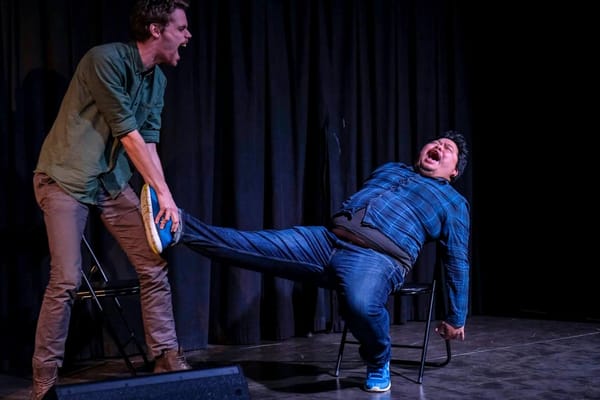Following up on the On Character article, the previous reveal that Jeff is a former colleague robbing the supermarket only works, of course, if he was wearing a mask to disguise himself so that the cashier wouldn’t recognize him. Should the actor have signaled to the audience that he was putting on a mask before he committed the robbery? No, for a couple of reasons.
Firstly, there’s no way to know at the start of the scene whether the mask is relevant at all. Yes, robbers wear masks, but if we purposefully show him putting on the mask we’re again messing around with Chekhov’s Gun. Since the twist was discovered, rather than invented, we had no guarantee that wearing a mask would become important.
Secondly, starting your scene by putting on a mask is lame. Starting a scene by raising your gun is cool.
Improv scenes work on a simple principle: anything can be potentially true until it’s said out loud. Then it simply becomes true.
It’s logical for a robber to wear a mask, so the fact that Jeff didn’t indicate he had one until he took it off is not a problem. The audience simply adjusts their mental picture retroactively: Jeff was apparently always wearing a mask. Makes sense.
There’s a good chance the ‘Jeff?’ line will get a laugh, and it gets a laugh for reasons that are unique to improv. Most times, these reasons will be processed subconsciously.
For one, the twist is funny because there was no way the actors could have agreed on it beforehand, and so the actors are as surprised as the characters are.
Secondly, the reveal depends on a piece of information that was missing for the audience: the cashier couldn’t recognize Jeff. But the actor playing the cashier was missing this information too, and the audience is enjoying both players incorporating this new fact to move on with the scene.
Yes, improv is for lazy people. But audiences love to see you work.
The real misconception is where the work actually takes place. As demonstrated previously, the setup isn’t nearly as complicated as non-improvisers are led to believe. Listen, agree, add. Set up your foundation. Create a character. You’re off to the races.
The real work of improv is completely optional, but it’s the most rewarding for both players and audiences: play to the top of your intelligence.
When I say ‘your’, I mean the actor, not the character. Playing dumb characters actually requires some intelligence as well (after all, how else would you recognize a lack of intelligence?). Here’s the good news: you don’t have to play to the top of your improv intelligence. I already said in the introduction that improv is simple. Instead, in order to create the world around you, you can use your own experiences, knowledge, taste and wit. We’ve done all the groundwork already. Now, we get to play.
This is also where a performer’s voice comes in. You’re the actor, the writer and the director, and you’re unique. No one has your background, your body, your mannerisms, or your sense of humor. Teaching improv is a gratifying business because although the fundamentals are the same, every single person can and does surprise me, especially if they’re playing to the top of their intelligence.
The foundation is called a foundation for a reason. We need a basic structure to support the scene before we can really let loose. This doesn’t mean we forget our cornerstones. In order to pave a way to a satisfying end for our scene, we still need to agree with the other actor, listen carefully and react. We have to stay consistent with our characters and the scene. But improv at its best defines these foundations as walls, not obstacles. And within those walls, anything goes.
Another metaphor that works here is a coloring book. We’ve drawn all the lines. Now we get to add whatever colors we like. So what colors are we missing? Let’s stick with the pattern we have going so far and list five.
Be physical.
You’re not just a bunch of talking heads. Improv is much more enjoyable for both the players and the audience if there’s a degree of physicality present. For actors, this means you should carefully choose your position on stage, how to stand or sit or even walk. A supermarket is a wonderful place to set a robbery. Isles of food, registers and shopping carts are everywhere. You can do a lot of environmental work there. None of this requires improv knowledge. You know what a supermarket looks like. So does the audience. They just don’t know what it looks like in your mind, and so they’ll always enjoy whatever you give them.
Then there’s also an interaction with objects. The cashier was probably operating the register before the robber walked in. Maybe they were putting in cash, or rolling a receipt, or scanning groceries. And the robber is holding a gun. You can be forgiven for now picturing someone extending their thumb and index finger while clenching the other fingers, a universal sign for ‘gun’. Don’t do that. This is what we call signaling, as opposed to miming. Miming a gun simply means pretending to hold a gun, which suddenly opens up all kinds of options. Is it a handgun? A BB gun? A shotgun? A bazooka? These options only work if you mime instead of signal. The same thing is true for phones. Extending your thumb and pinky, clenching the other fingers and then holding your hand to the side of your head is a commonly recognized signal for ‘phone’, but you can’t chuck it across the stage.
Interestingly, this is the one area where the principle of Chekhov’s Gun doesn’t need to apply. The fact that you’re holding a handgun rather than a shotgun doesn’t have to mean anything. The audience’s brains will file this under ‘production design’ for your improvised play. In fact, you sometimes don’t have to talk about your object work at all. Why would a cashier talk about doing cashier things while they’re scanning groceries? This is the most normal thing in the world. Don’t talk about what you’re doing unless what you’re doing is meaningful for the scene.
Just like environmental work, you don’t need improv knowledge to mime properly on stage. Want to practice how to hold an imaginary cup? Hold a real cup.
However, sometimes object work is not just flavor but can actually influence the scene. Let’s assume for a moment that in our grocery store setup, the actor playing the robber is miming a small gun. The other actor might pick up on this. The scene continues:
A: I never gave up easily! I did my job, every day. I would’ve gotten shot in the line of duty if it meant defending this place! So why is it me who got fired?!
B: …Jeff?
A: Yes. It’s me. (They take off the mask.)
B: What are you holding, anyway?
A: It’s a gun.
B: It’s pretty small, isn’t it?
A: So?
B: So it looks a lot like the toy guns we sell.
There’s some careful navigating going on over here. The other actor isn’t disagreeing with the idea of the gun, but they’re adding something to it: with a gun that small, there’s a chance it’s a toy. And since they’re in a supermarket and Jeff used to work there, it might be fun to imply Jeff took a toy gun to try and rob his former employer.
Again, none of this requires any improv knowledge. The one actor simply saw the other actor mime a small gun, took a look at what they knew already (they’re in a supermarket, and their robber is their former colleague), and connected some dots. They’re just using their own intelligence.
None of this dialogue is important. Ultimately, it doesn’t matter whether Jeff has a toy gun or a real gun: what matters is he tried to rob the place. But taking an actor’s physicality and connecting it with the scene is rewarding for the audience, and makes it seem like more than a bunch of talking heads. It’s simple but fun.
Be specific.
Specificity is funny. Instead of trying to be creative in the scene (which I’ve already pointed out is a bad idea), try to be creative in the specifics. It adds tons of color to a scene, is wonderfully dependent on the actor (everyone has a different background and vocabulary) and makes a scene much funnier. Since surprise is the key to all humor, gratuitous specificity is a great source of comedy.
This doesn’t mean you have to invent things out of thin air. It simply means reacting to something in such a way that you can add details that don’t exist for any other reason than to tickle the audience. This can effortlessly go along with reacting to the other person:
B: It’s pretty small, isn’t it?
A: So?
B: So it looks a lot like the toy guns we sell.
A: (Desperate) This is a Glock 47!
B: That is a Fisher Price Blaster.
Note that making these guns specific is much funnier than saying it’s real versus fake. Side note: this disagreement would only be a problem if it was the actors disagreeing. It isn’t. Player A’s desperation means they’re agreeing with the fact that it’s a toy gun, but they’re also playing a character that wants to hide the fact that it’s not a real weapon. That’s why it’s important to pay attention to physicality and acting.
You might not know what a Glock 47 or a Fisher Price Blaster is. That’s okay. Either you know different weapons, or you can make up your own names that sound vaguely believable. As a matter of fact, I’m incredibly done with this weapons example, but I’ve now committed to the robbery scene, so I have to run with it. Let’s add a few more lines, just for flavor.
A: (Desperate) This is a Glock 47!
B: That is a Fisher Price Blaster. I can’t believe it. We let you go on Monday, and you come back on Wednesday to rob the place?
A: I ran out of money!
B: That quickly?
A: You all know I live an expensive life!
There are two details here, one of which is just color, and one of which will lead to our next line. The first detail is that Jeff was fired on a Monday and has come back on a Wednesday. The audience will do a quick calculation that this is only two days. Jeff is a man of action. It also means he ran out of money incredibly fast. Doing the calculation from Monday to Wednesday (specific, funny) is more entertaining than telling the audience that Jeff came back quickly.
The other detail is that Jeff ‘lives an expensive life’. This detail is an important character trait. What kind of grocery store worker ‘lives an expensive life’? The other important part of that sentence is ‘You all know’, because it’s actually an invitation for the other player. It’s actor code for ‘your character knows me, so now you can work together with me to define him’. Which brings us to principle three:
Have a history.
There will always be scenes where characters meet for the first time. There are situations where they simply must. But if you have the choice, it’s fun for the characters to have a shared history. There are a few reasons for this. Characters that don’t have a history together are either forced to focus on the situation rather than the relationship, or they’re forced to tell each other about each other. Number one isn’t great because character is king, and number two isn’t great because in storytelling you want to show the audience things rather than tell them. Remember: character is demonstrated through action.
Of course, scenes between strangers happen all the time, but it’s crucial to realize they’re considerably more difficult to play well than scenes between people who know each other. If you’re just beginning with improv, consider having the characters know each other.
In fact, that’s what happened here: the actors took a setup that looked like an encounter between two strangers, and turned it into a meeting between former colleagues. Because they now have a shared history, it’s easier to make the characters more specific. Let’s combine principle two and principle three for a moment, and be specific while mentioning a history:
B: That quickly?
A: You all know I live an expensive life!
B: I know you drive a Tesla.
A: Yes!
B: And that you like designer clothes.
A: Yes!
You can feel it, can’t you? That whatever the third detail is, that’s the one that will have to move the scene forward. In comedy, good things come in threes. The reason for this is as follows: comedy relies on patterns and surprises, and brevity is the soul of wit (source: some guy named Shakespeare). And the shortest pattern consists of three things. Just watch any comedy show and see how often this rule is followed: a list of two things followed by a surprise in the third.
So what could it be? Well, we’re not being randomly creative. Whatever the third thing is, it has to be something that everyone knows about Jeff. It has to have something to do with money. And most importantly, it has to do something with the scene rather than be a random detail. We’re in a grocery store. So…
A: You all know I live an expensive life!
B: I know you drive a Tesla.
A: Yes!
B: And that you like designer clothes.
A: Yes!
B: And that you do your shopping at…
Wait a second.
B: Wait a second.
A: What?
B: You don’t even shop at this supermarket!
A: So?
B: So what’s all this stuff about company loyalty?
There we go. Player B used something from the character’s past (which, of course, is made up on the spot) to inform the character’s present. Importantly, this is the only way in which you should ever use the past. If character is action, then the reveal of character should happen in the moment. The audience only cares about the present. The characters knowing each other simply provides an easy shorthand to reveal more about each other right now.
And what did they do? They tied it back to the beginning of the scene! Which brings us to principle four:
Audiences love symmetry.
Humans are pattern recognition machines. Even small children appreciate the feeling they get when they match the right toys with each other. Audiences love to be rewarded for paying attention.
Good news: everything you do as an improviser creates the ideal circumstances for symmetry. After all, you know you need to always agree with the other actor (but not their character), and you know you always need to maintain consistency with your own character and their attitude. This means that sooner or later one of the characters will point out something that happened earlier on.
In normal storytelling, audiences will appreciate symmetry because returning to the beginning might reinforce certain themes or remind us of changes that the character has/has not gone through (more on that for point five). That’s why so many television shows do flashback episodes.
In improv, there’s a second level of appreciation, which is that actors who can return us to the beginning prove that they have been paying attention, too. It gives the whole scene the illusion of being one big masterplan from the start, even though it’s of course a complete coincidence that we ended up here. As I previously said, good improv means creating the kind of circumstances where these kinds of accidents happen all the time. Listen well. Be consistent. The rest of the dialogue is just replying logically.
B: You don’t even shop at this supermarket!
A: So?
B: So what’s all this stuff about company loyalty?
A: Just because I work here doesn’t mean I have to shop here.
B: But that means that none of the money you’re taking from us is yours! Why don’t you rob the supermarket you normally go to instead? That would be company loyalty!
A: Because…
B: Yes?
A: Because they didn’t fire me.
It’s a journey.
Just like audiences love symmetry, they also want to be rewarded at the end of the scene. Since we know scenes are really about characters, the question is pretty much always the same: will the character change, or will they stay the same? Player A admitting that they’re really robbing the place out of vengeance rather than just for money means that we’ve now come to their moment of truth. Will they abandon their robbery and become a better person or will they double down? Either way is great. The only bad choice would be not to make one and keep them exactly the same.
Though it wasn’t pointed out in the dialogue itself, the audience can sense an interesting reversal has taken place. Whereas in the beginning Player B was terrified and Player A seemed to have the upper hand, Player B now realizes that with a toy gun, it would be impossible for the robbery to be successful. Not only that, but Player B now knows the identity of Player A. So the high status and low status I mentioned previously also apply here, but it applies to the dynamic rather than the characters themselves. There’s been a reversal, so there’s been a change. The audience senses this, too. None of this requires much thinking: it’s just playing with the elements we introduced at the start. Now the actors have to follow the scene to its logical conclusion.
Here’s the fact of the scene: the robbery could never be concluded successfully. Player B now has all the power. One option is for Player A to take their toy gun and leave, but we don’t really want that. De-escalation is something that happens in real life, not in stories. Things either get worse, or there’s a big change. So what to do?
We have to get back to character.
A: Because…
B: Yes?
A: Because they didn’t fire me.
B: Does it hurt you so much?
A: I would’ve taken a bullet for this company. And they fired me on Monday.
B: So?
A: Monday was my birthday.
Note how the irrelevant but funny detail we introduced earlier can now be brought back for an additional character moment. It’s a blatant attempt to get sympathy from the audience, but it totally works. Not only that, but it creates an opportunity to get sympathy from the other character, too:
A: Monday was my birthday.
B: Aw, jeez. I’ll tell you what.
A: What?
B: Take the money. I’ll pretend I didn’t see who you were.
A character’s choice again presents us with the next moment! But remember character consistency? Let’s bring back the comedy with Player A:
B: Take the money. I’ll pretend I didn’t see who you were.
A: You would give me the money even though you’re not under any threat?
B: Sure.
A …You really have no company loyalty!
There’s a lot of callbacks in this short text, and it’s internally consistent. But I promise you that I didn’t write out this text earlier on to demonstrate these principles. I’ve improvised it as I went along, and I haven’t rewritten anything. All I did was follow the rules. That’s how the journey works.








Member discussion